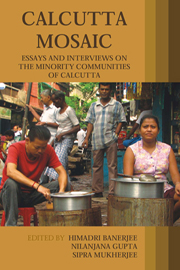Book contents
- Frontmatter
- Contents
- List of Contributors
- Acknowledgements
- Introduction
- 1 Mapping the Spaces of Minorities
- 2 The Armenians of Calcutta
- 3 The Jews of Calcutta: An Interview with Michael Ezra
- 4 The Sindhis of Calcutta
- 5 The City of Colleges
- 6 The Chinese Community of Calcutta
- 7 The Anglo–Indians of Calcutta
- 8 The Biharis of Calcutta
- 9 Agraharis of Calcutta
- 10 A Journey into My Neighbourhood
- 11 The ‘South Indians’ of Calcutta: Experiences in Cultural Processes
- 12 ‘Non-Bengali’ Icons of Malevolence
- 13 Selfing the City
Introduction
Published online by Cambridge University Press: 05 March 2012
- Frontmatter
- Contents
- List of Contributors
- Acknowledgements
- Introduction
- 1 Mapping the Spaces of Minorities
- 2 The Armenians of Calcutta
- 3 The Jews of Calcutta: An Interview with Michael Ezra
- 4 The Sindhis of Calcutta
- 5 The City of Colleges
- 6 The Chinese Community of Calcutta
- 7 The Anglo–Indians of Calcutta
- 8 The Biharis of Calcutta
- 9 Agraharis of Calcutta
- 10 A Journey into My Neighbourhood
- 11 The ‘South Indians’ of Calcutta: Experiences in Cultural Processes
- 12 ‘Non-Bengali’ Icons of Malevolence
- 13 Selfing the City
Summary
It is believed that Job Charnock stepped out gingerly from his merchant boat onto the banks of the river Ganga near the village Kalikata on 24 August 1690. This brought to the world the news of a tiny Bengal village, Kalikata. But was Kalikata really unknown till then? Though the history of the city is generally dated from Charnock's entry, this story of the origin was challenged by the Sabarna Roy Chaudhury family. Signed on 10 November 1698, at Barisha Atchala, the deed of lease of the three villages of Bengal – Sutanuti, Kalikata and Govindapur, was drawn up between Sabarna Ray Chaudhury's family and Job Charnock's son-in-law Charles Eyere. Till recently, this event had been viewed as the moment at which Calcutta entered the history of Bengal. But when, on 16 May 2003, in a case that became famous as the Calcutta Birthday Case, the High Court of Calcutta ruled that neither could ‘Charnock be regarded as the founder of Calcutta, nor (could) the claim that Calcutta was born on 24 August, 1690’ be substantiated historically, that judgement was almost entirely based on the finding that the history of Calcutta stretched way into the centuries past before Charnock had even set foot on Indian soil. The city of Kalikata or Calcutta has emerged through a very long history that spans over five or six centuries. The poet Bipradas Piplai's Manasa Vijaya, written in 1495, alludes to a place called Kalikatah.
- Type
- Chapter
- Information
- Calcutta MosaicEssays and Interviews on the Minority Communities of Calcutta, pp. 1 - 22Publisher: Anthem PressPrint publication year: 2009



